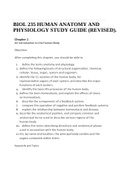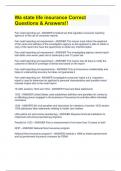Exam (elaborations)
BIOL 235 HUMAN ANATOMY AND PHYSIOLOGY STUDY GUIDE (REVISED).
- Course
- Institution
BIOL 235 HUMAN ANATOMY AND PHYSIOLOGY STUDY GUIDE (REVISED). Chapter 1 An Introduction to the Human Body Objectives After completing this chapter, you should be able to 1. define the terms anatomy and physiology. 2. define the following levels of structural organization: chemical, cellular, ...
[Show more]




